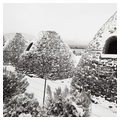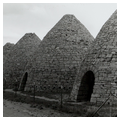These six identical conical stone structures would stand out anywhere, but their appearance in a quiet, empty landscape makes them seem like mysterious apparitions. By no means the only collection of stone charcoal kilns in the state (others can be found in Bristol and in the Spring Mountain National Recreation Area near Las Vegas), these structures are the best preserved and most accessible.
Charcoal was necessary to fire up the smelter furnaces used to process ore. Various methods and structures were employed to make charcoal for furnaces in Nevada; in the Eureka area, carbonari used primitive platform kilns. Cords of stacked wood, covered with sod or more wood, smoldered for several days until the wood became charcoal. Stone or brick kilns could greatly improve the process. These six ovens were built to supply the Ward Mining District, opened after the discovery of silver and gold in 1872 but shut down seven years later.
The ovens measure 25 feet in diameter at the base and 30 feet in height. The stones are laid up dry, with vents around the bottom of the wall. A large arched opening with voussoirs gives access at the base of the oven, and an arched window pierces the upper rear wall. A hole at the top allowed smoke to escape. Thirty-five cords of wood, usually piñon or juniper, were stacked inside through the door and window; these openings were then sealed with iron doors and a fire was started. Carbonari controlled the temperature of the fire by plugging and unplugging the vents at the base of the oven.




